
How to find the best Etsy keywords in 3 simple steps using Alura
If you want to be found in search results on Etsy, you need to optimize your product listing for SEO. And if you want to
join
If you’re at the beginning of your handmade business journey, I’ve got something for you! It’s a guest post by Sharayah from The Abundant Artist, and she’s going to show you 3 steps to monetize your creativity without selling your soul. Ready? Let’s dive in!

FREE WORKBOOKS, CHEAT SHEETS, AND RESOURCES TO HELP YOU START, GROW AND PROFIT FROM YOUR HANDMADE SHOP.
If you have a creative streak, whether it’s sculpting tiny flower pots or still life painting, it’s likely that at some point in the past someone close to you has told you that you should sell your work. The idea is appealing- if you’re making the work anyway, why not make a few bucks? But there’s an ever-present fear among artists who haven’t already made art their full-time business: how can I sell my work without “selling out” or losing the heart of what makes my work unique?
The great news is that, just like the myth of the starving artist, the notion that a creative soul must “sell out” in order to make money from their work is nothing more than a fairy tale. Artists can and do make a fantastic living doing what they love, no starving necessary- and no deals with the devil either. The key to remaining true to your vision is to identify what makes your work unique, learn how to tell your story, and decide how you’ll make money. If the quality of your work is decent, the amount of money you can make from your art will depend mostly on how much work you’re willing to put in- with diligence you can create a nice side-hustle, or even quit your day job.
The first step to learning how to monetize your creativity without selling out is to take a hard look at the work you’re already creating. It’s okay to be a renaissance soul who likes to try new things, but in order to sell you should have a collection of work that appears to be a coherent series (so you would probably not try to sell macrame wall hangings and pet portraits together). This is a great time to solicit the help of not just friends and family, who are probably big fans already, but also fellow artists and objective individuals. Ask for their feedback: what stands out to them about your art? Here are a few more ways to help you identify what makes your work stand out:
Learning how to tell the story of your art will help you transition from a wandering creative soul to a professional with a clear vision, and all without losing your sense of self or the vision you have for your work. Your story is composed of what led you to create your art, the challenges you have overcome along the way, and what motivates you to continue. Think back to the previous exercise. What is special about the subject(s) of your work? Why did you choose to begin sketching horses, or painting murals of roses, or whatever it is you do? What obstacles have stood in the way, and how have you overcome them?
The reason your story is so important is that when you sell a piece of art, it isn’t just the work you’re selling. You’re selling an emotional experience, from beginning to end. Telling a story, both about yourself as a creative and about the individual pieces, creates a shortcut for emotional connection with your potential customers. And an emotional connection isn’t just more likely to sell a piece of art- it’s more likely to create repeat customers and raving fans.
Once you’ve pinpointed what makes your work unique and figured out how to present yourself and your work in a compelling way, you’ll want to make that story consistent and coherent across social media platforms, on your website if you have one (and you should if you want to sell your creative work), and in person.
Here are a few great examples of artists who tell their story in a clear and compelling way:
The internet has, in many ways, absolutely leveled the playing field for creatives with decent work who are willing to show up and put in the hours necessary. Depending on whether you just want to sell embroidered pillows on the side or you want to quit your day job and make floral oil paintings full time, there’s a business model that will work for you. It may take some trial and error to discover what really works for you (you’ll need to know where your audience is and how they like to purchase art). The main business models for artists are:
Each model requires different ways of doing business, but each will require that you know what makes your work unique and how to tell your story, and none of them will require that you change who you are or drift from your personal creative vision if you don’t want to. So why not give selling your art a try?
And of course, if selling your art is not true to who you are, that’s fine too. If, after going through this process, you decide that you don’t want to focus on a single line of work, or you just want art-making to be a hobby, that’s really great! You can let go of the need to sell, and begin telling your well-meaning friends and family that you have no interest in selling, but you’ll gladly gift them a new piece. Not everything has to be a side hustle, and that’s beautiful.

Sharayah Pranger writes for TheAbundantArtist.com, where artists learn how to sell their art online. In her spare time she likes to draw, crochet, and prevent her two young children from burning the house down.
you might also like…
related articles

If you want to be found in search results on Etsy, you need to optimize your product listing for SEO. And if you want to

There has been a lot of talk in the Etsy community — and I mean A LOT of talk — about Etsy’s payment account reserve

Anyone who knows me knows that I am a HUGE advocate for using email marketing to grow and scale your handmade business. But you may
Sign up below and get instant access to a collection of FREE practical guides, workbooks, and checklists that will help you start, grow and profit from your handmade shop. (without pulling your hair out!).
disclaimer
subscribe to youtube
become a member
get in touch
We acknowledge and give thanks to the Budawang and Yuin people, the Traditional Owners of the land we work and live on. We pay our respects to all Aboriginal and Torres Strait Islander Peoples and elders past, present and emerging.
4-step Maker’s Roadmap System
Library of In-Depth Courses and Training
Live Monthly Coaching Sessions
A Supportive Online Community
close
We hate spam too. Unsubscribe at any time.
close
We hate spam too. Unsubscribe at any time.
close
We hate spam too. Unsubscribe at any time.

Get Instant Access to
The FULL Resource library
Thanks Sharayah, really helpful advice and post.
Hi, this article has a lot of great tips, but I disagree. You can be a sell out, but it’s not what you think. It’s not from selling your art work or becoming a professional artist. I believe it is from selling your ideals to make money. If you are passionate about something and you take money from someone to make something you don’t feel comfortable with in order to become popular or rich you have sold your soul.
Mind you I really don’t think that an artist on Etsy or selling something in an art fair will be forced to make this choice. I believe the idea of selling out is more about greed and pride. Not about someone trying to pay bills with a second job as an artist.
Great article! Thanks!
Thanks for sharing your feedback and appreciating our article, Pour Tea Cup!